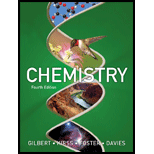
Concept explainers
(a)
Interpretation: The molecular ions with one or more unpaired electron from the given molecules are to be identified.
Concept introduction: When two atomic orbitals come close to each other they lose their identity and form new pair of orbitals knows as molecular orbitals. Among the two molecular orbitals formed, one has energy lower than the atomic orbitals is known as bonding molecular orbital and the other has energy higher than the atomic orbitals and is known as antibonding molecular orbital. The filling electrons in molecular orbitals follow Aufbau’s principle and Hund’s rule.
To determine: If the molecular ion
(a)
Answer to Problem 9.93QP
Solution
The
Explanation of Solution
Explanation
Nitrogen has five valence electrons.
The total number of valence electrons in
According to the molecular orbital theory, the electronic configuration of
One unpaired electron is present in
(b)
To determine: If the molecular ion
(b)
Answer to Problem 9.93QP
Solution
The
Explanation of Solution
Explanation
Oxygen has six valence electrons.
The total number of valence electrons in
According to the molecular orbital theory the electronic configuration of
One unpaired electron is present in the
(c)
To determine: If the molecular ion
(c)
Answer to Problem 9.93QP
Solution
The
Explanation of Solution
Explanation
Carbon has four valence electrons.
The total number of valence electrons in
According to the molecular orbital theory the electronic configuration of
One unpaired electron is present in the
(d)
To determine: If the molecular ion
(d)
Answer to Problem 9.93QP
Solution
The
Explanation of Solution
Explanation
Bromine has seven valence electrons.
The total number of valence electrons in
According to the molecular orbital theory the electronic configuration of
No unpaired electron is present in any orbital of
(e)
To determine: If the molecular ion
(e)
Answer to Problem 9.93QP
Solution
The
Explanation of Solution
Explanation
Oxygen has six valence electrons.
The total number of valence electrons in
According to the molecular orbital theory the electronic configuration of
One unpaired electron is present in the
(f)
To determine: If the molecular ion
(f)
Answer to Problem 9.93QP
Solution
The
Explanation of Solution
Explanation
Oxygen has six valence electrons.
The total number of valence electrons in
According to the molecular orbital theory the electronic configuration of
No unpaired electron is present in any orbital of
(g)
To determine: If the molecular ion
(g)
Answer to Problem 9.93QP
Solution
The
Explanation of Solution
Explanation
Nitrogen has five valence electrons.
The total number of valence electrons in
According to the molecular orbital theory the electronic configuration of
Two unpaired electrons are present in
(h)
To determine: If the molecular ion
(h)
Answer to Problem 9.93QP
Solution
The
Explanation of Solution
Explanation
Fluorine has seven valence electrons.
The total number of valence electrons in
According to the molecular orbital theory the electronic configuration of
One unpaired electron is present in
Conclusion
The molecules which contain unpaired electrons in their molecular orbitals are paramagnetic in nature. All the molecular ion species except
Want to see more full solutions like this?
Chapter 9 Solutions
Chemistry
- Show the mechanism steps to obtain the lowerenergy intermediate: *see imagearrow_forwardSoap is made by the previous reaction *see image. The main difference between one soap and another soap isthe length (number of carbons) of the carboxylic acid. However, if a soap irritates your skin, they mostlikely used too much lye.Detergents have the same chemical structure as soaps except for the functional group. Detergentshave sulfate (R-SO4H) and phosphate (R-PO4H2) functional groups. Draw the above carboxylic acidcarbon chain but as the two variants of detergents. *see imagearrow_forwardWhat are the reactions or reagents used? *see imagearrow_forward
- The two pKa values of oxalic acid are 1.25 and 3.81. Why are they not the same value? Show the protontransfer as part of your explanation. *see imagearrow_forwardасть Identify all the bonds that gauche interact with C-OMe in the most stable conformation of the above compound.arrow_forwardPredict the reactants used in the formation of the following compounds using Acid-Catalyzed dehydration reactionarrow_forward
- Can I please get help with this?arrow_forward.. Give the major organic product(s) for each of the following reactions or sequences of reactions. Show ll relevant stereochemistry [3 ONLY]. A H Br 1. NaCN 2 NaOH, H₂O, heat 3. H3O+ B. CH₂COOH 19000 1. LiAlH4 THF, heat 2 H₂O* C. CH Br 1. NaCN, acetone 2 H3O+, heat D. Br 1. Mg. ether 3. H₂O+ 2 CO₂ E. CN 1. (CH) CHMgBr, ether 2 H₂O+arrow_forwardAssign this COSY spectrumarrow_forward
 ChemistryChemistryISBN:9781305957404Author:Steven S. Zumdahl, Susan A. Zumdahl, Donald J. DeCostePublisher:Cengage Learning
ChemistryChemistryISBN:9781305957404Author:Steven S. Zumdahl, Susan A. Zumdahl, Donald J. DeCostePublisher:Cengage Learning ChemistryChemistryISBN:9781259911156Author:Raymond Chang Dr., Jason Overby ProfessorPublisher:McGraw-Hill Education
ChemistryChemistryISBN:9781259911156Author:Raymond Chang Dr., Jason Overby ProfessorPublisher:McGraw-Hill Education Principles of Instrumental AnalysisChemistryISBN:9781305577213Author:Douglas A. Skoog, F. James Holler, Stanley R. CrouchPublisher:Cengage Learning
Principles of Instrumental AnalysisChemistryISBN:9781305577213Author:Douglas A. Skoog, F. James Holler, Stanley R. CrouchPublisher:Cengage Learning Organic ChemistryChemistryISBN:9780078021558Author:Janice Gorzynski Smith Dr.Publisher:McGraw-Hill Education
Organic ChemistryChemistryISBN:9780078021558Author:Janice Gorzynski Smith Dr.Publisher:McGraw-Hill Education Chemistry: Principles and ReactionsChemistryISBN:9781305079373Author:William L. Masterton, Cecile N. HurleyPublisher:Cengage Learning
Chemistry: Principles and ReactionsChemistryISBN:9781305079373Author:William L. Masterton, Cecile N. HurleyPublisher:Cengage Learning Elementary Principles of Chemical Processes, Bind...ChemistryISBN:9781118431221Author:Richard M. Felder, Ronald W. Rousseau, Lisa G. BullardPublisher:WILEY
Elementary Principles of Chemical Processes, Bind...ChemistryISBN:9781118431221Author:Richard M. Felder, Ronald W. Rousseau, Lisa G. BullardPublisher:WILEY





